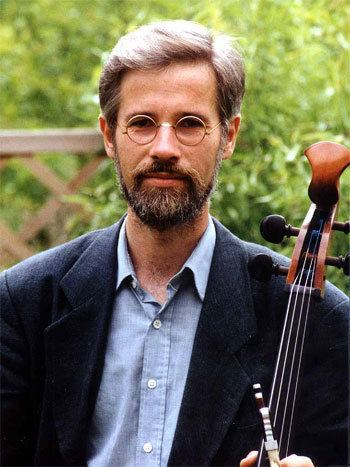Michael Denhoff (born 25 April 1955 in Ahaus) is a German composer and cellist.
Denhoff has lived and worked in Bonn since 1982. He studied at the Musikhochschule in Cologne, where his teachers included Günter Bialas and Hans Werner Henze (composition), Siegfried Palm and Erling Blöndal Bengtsson (cello) and the Amadeus Quartet (chamber music). As a composer and chamber musician, he occupied various teaching posts, including a lectureship in composition at the University of Mainz (1984–85) and a guest professorship at the National Conservatory of Hanoi (1997–99). From 1985 to 1992 he also conducted the Akademische Orchester Bonn, which he founded. As a cellist, he formed the Denhoff Piano Trio with his brother Johannes (violin) and the pianist Richard Braun. Since 1992, he has been a member of the Ludwig Quartet of Bonn, and he also works closely with the pianist Birgitta Wollenweber. As a composer, he has won several prizes and distinctions, including the Bernd Alois Zimmermann Prize (1986) and the Annette von Droste-Hülshoff Prize (1989).
Denhoff's music shows the influence of poetry and the visual arts. Several of his orchestral and chamber works have been inspired by lyrics and paintings. Thus, there are instrumental works and cycles based on pictures by Marc Chagall, Paul Klee, Wassily Kandinsky, Albrecht Dürer and especially Fransisco Goya (El sueño de la razon produce monstruos, 1982; Desastres de la guerra, 1983; Los disparates, 1988). The literary figures who have most left their mark on his music are Ranier Maria Rilke, Paul Celan, Samuel Beckett and Stéphane Mallarmé. Other works characteristic of his compositional thought include cycles in the form of 'musical diaries' (Klangtagebuch, 1984; Hebdomadaire, 1990). The most significant of these works is the piano quintet Hauptweg und Nebenwege (1998), which lasts nearly three hours. This piece gathers together the essential aspects of his music, their relationship to musical tradition, and also the influences of literature and the visual arts.
Denhoff's compositional vocabulary shows evidence of a sensitive feeling for harmony and form, whose roots are to be found in composers such as Bernd Alois Zimmermann, Olivier Messiaen, Morton Feldman and György Kurtág.
CDs featuring Denhoff's works are available on the WERGO, Col Legno and Cybele labels.
DER PELIKAN – Kammeroper nach Strindberg op. 64TRAUMBUCH EINES GEFANGENEN für Bariton, Sprecher, Chor und Orchester op. 51IN UNUM DEUM – Credo für Sopran, Bariton, Chor, Orgel und kleines Orchester op. 93MAGNIFICAT für Chor mit zwei Soloquartetten, Saxophonquartett und vier Schlagzeuger op. 98VOZ MIA, CANTA, CANTA op. 37 Liederzyklus nach Gedichten von Juan Ramón JiménezTHE DIMENSION OF STILLNESS op. 58CREDO op. 93aWIE EINE LINIE DUNKELBLAUEN SCHWEIGENS op. 80 - Sieben Gesänge nach Gedichten von Selma Meerbaum-Eisinger für Mezzosopran und AkkordeonSILENCE, ET PUIS op. 101 - Fragmente nach letzten Notaten von Marguerite Duras für Altstimme und ViolaMELANCOLIA - Annäherungen an einen Kupferstich von Dürer op. 26EINSAMKEIT - in memoriam W. Buchebner op. 33DESASTRES DE LA GUERRA – Orchesterbilder nach Goya op. 36NACHTBILD (Mahler-Momente) op. 57INNENRÄUME…ERINNERND op. 71MATCH für Saxophonorchester und gr. Trommel op. 90UMBRAE - in memoriam B. A. Zimmermann - für Violine, Violoncello und Orchester op. 13OMAGGIO für Violine, Oboe und Orchester op. 40REMARKS AND REVIEWS für Saxophonquartett und Orchester op. 689 String Quartets (Opp. 1, 19, 30, 55, 66a, 70, 73, 79, 83a)5 Piano Trios (Opp. 7, 27, 74-1, 74-2, 83b)4 Saxophone Quartets ("gegen-sätze" Op.39, "svolgimenti" Op.46, "pnoxoud" Op.59, Fünf geistliche Gesänge Op.98a)Moment Musical for Viola and Piano (1973)Champs de Mars, Inventions after Marc Chagall for Viola and Piano, Op.9 (1975)Los Disparates, Sketches after Goya for Viola, Cello and Double Bass, Op.54 (1988)Two Once So One for String Quartet, Viola and Cello, Op.66 (1992)Mallarmé-Zyklus, 12 Quartets for 12 Musicians, Op.75 (1995–1996)Tenebrae for Viola and Piano, Op.82 (1997)Hauptweg und Nebenwege, Aufzeichnungen für Streichquartett und Klavier, Op.83 (1998)To and Fro in Shadow, "Nebenweg IV" for Viola and Piano, Op.83d (1998–1999)Igitur, Lesart für Kammerensemble, Op.85 (1998)Sounds and Shadows for Piano, String Quartet and Viola (or Clarinet), Op.86 (1999)...Ins Ungewisse... (Luigi Nono In Memoriam) for Violin and Double Bass, Op.97 (2004)...Ouvert..., Meditation für variable Besetzung, Op.99 (2005)Maramba (zur Erinnerung an Paula Köhlmeier) for Flute (also Bass Flute) and Celesta, Op.100 (2005)Silence, et puis for Alto Voice and Viola, Op.101 (2006)Rue Sedaine, 11 P.M. for Ensemble, Op.104 (2007)Zwei Stücke (Two Pieces) for Viola and Cello (2007)NACHTFANTASIEN (zu Rilke-Gedichten) für Gitarre op. 31AUS TIEFER NOT - Anrufung für Orgel op. 41ATEMWENDE – Klavierzyklus nach Paul Celan op. 49, 1-7MONOLOGE I – V für fünf Solisten op. 50, 1-5HEBDOMADAIRE – 52 Stücke vom Jahr für einen Pianisten op. 62SKULPTUREN I – V für Klavier op. 76, 1-5INVENTIONEN I – XII für Player-Piano op. 88, 1-12...AL NIENTE... für Klavier op. 95NACHTSCHATTENGEWÄCHSE - neun Stücke für Klavier op. 96Stille und Umkehr - Betrachtungen zum Phänomen Zeit, in: MusikTexte, Heft 24 (1988), S. 27 - 38Rituel von Pierre Boulez - Anmerkungen zur Raum- und Zeitkonzeption, in: Festschrift zum 60. Geburtstag von Prof. Dr. Emil Platen, Bonn (1985), S. 208 - 219Max Reger. Ein für die Musik des 20. Jahrhunderts zu Recht unterschätzter Komponist?! Eine Musikbefragung, in: REGER-STUDIEN 4, Breitkopf & Härtel (1989), S. 105 – 124, 233 – 253Vom Bild-Klang zum Klang-Bild - zum Verhältnis von Bild und Musik in meinen Stücken, in: NZfM 1993 / 6, S. 14 - 19THOMAS SCHÄFER: Michael Denhoffs „Nachtbild”: Nähe als Hindernis; in: Modellfall Mahler - kompositorische Rezeption in zeitgenössischer Musik. Wilhelm Fink Verlag München 1999
